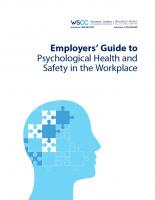Occupational Health and Safety (OHS) programs are often focused on eliminating physical hazards and preventing bodily injuries or accidents in the workplace. However, a healthy and safe workplace should plan for both the physical hazards employees may face in their day to day work, and also address psychological health and safety.
Examples of psychological health and safety concerns include: pace and hours of work, fatigue, existing anxiety or stress disorders, conflict at work, and working in social isolation. Psychological injuries, like post-traumatic stress disorder, can develop as a result of a physical injury.
To address this frequent gap in OHS programs, the CSA Group developed a National Standard for psychological wellness in workplaces across Canada [(National Standard of Canada for Psychological Health and Safety in the Workplace (CSA Standard CAN/CSA-Z1003-13/BNQ 9700-803/2013)].
WSCC has developed an Employers’ Guide to Psychological Health and Safety in the Workplace to assist employers in Nunavut and the Northwest Territories with implementing the National Standard.

